
Vasistha Samhita (Yoga Kanda)
Book Specification
| Item Code: | IDF292 |
| Author: | Editors & Commentators Philosophico-Literary Research Department |
| Publisher: | Kaivalyadhama Samiti Lonavla |
| Language: | English |
| Edition: | 2022 |
| Pages: | 291 (Illustrated With B & W Figures) |
| Cover: | Paperback |
| Other Details | 8.8" X 5.6" |
| Weight | 480 gm |
Book Description
From the Back of the Book:
"Very often philosophical gymnastics is mistaken for spiritual knowledge. It is to be remembered, however, that no intellectual convictions or philosophical training will taken an individual even a wit nearer to the Lord. Practical experiences in the sublime regions of adhyatma can definitely be made possible through the psychophysiological processes of Yoga"
- Swami Kuvalayananda
As regards the content of Vasistha Samhita the introduction is fairly exhaustive. But as far as the original text is concerned a dire need was felt to re-edit it in order to make it faultless and more complete yogic text. We in this critical edition have re-investigated certain issues felt by us against previously published edition of this text and we have made subsequent changes wherever it was felt necessary.
The first and foremost issue is with regards to the extent of the text itself. The Vasistha Samhita published from Kaivalyadhama in 1969 A.D. contained eight chapters because almost all the MSS of this text refer to all those eight chapters. Considering the manuscript to be the only authentic source the editors of the previous edition had retained all these eight chapters and gave the title Vasistha Samhita Yoga Kanda. But the subject matter of 7th and 8th chapters. Even though the whole text was named as Yoga Kanda of Vasistha Samhita the two chapters mentioned above deal with the subject matter of astrology and astronomy and hence they show the least connection with the subject matter of Yoga. Even if it is accepted the they are found in all the MSS of Vasistha Samhita and they were written by Sage Vasistha these chapters in a book which has nothing to do with any other branch of knowledge than yoga. A writer can write on many subjects and it is possible that Vasistha was a great astrologer and astronomer but here our aim is to bring forth Vasistha’s contentions on Yoga and then only the title Vasistha Samhita Yoga Kanda will be justified. Therefore the present edition of the text contains only six chapters. The 8th chapter of the previous edition has become the 6th chapter of the present edition. The six chapters exhaustively deal with the subject matter of Yoga hence the sixth and seventh chapters of previous edition have not been included here.
We have all the respect and regard to sage Vasistha and also for the editors of the previous edition. In order not to disappoint the reader specially the researches who want to acquaint themselves with the astrological and astronomical notions of Vasistha we have included these two chapters as they are found in the manuscripts in the appendix of the Hindi edition.
The second issue concerned with the present edition is that of the accurate reading of the text. In this connection we had certain principles for determining the correct reading of the verses. These principles are (1) Context, (2) Meaning according to the context (3) grammatical elements (4) Meter.
It gives us immense satisfaction in presenting the Revised Edition of Vasistha Samhita (English) before our Yoga lovers. Since Vasistha Sarnhit5 contains insightful information on Yogic anatomy i.e. Yogic body wisdom in terms of nãdi, väyu, niarmasthänas, on unique practice of pratyTh5ra in terms of vital points, enlightening instructions on dharana and dhyana etc. its English Translation Edition (1984) in due course of time became out of print and its Reprint was due since long. So according to our earlier plan, we were to bring out the Reprint Edition of the same. However, while working on the project, we felt the need of bringing parity between the Vasistha Samhitã Critical Edition in Hindi and the present English Edition. Accordingly, the present revised critical edition contains Variant Readings available in the MSS consulted for this critical edition. The inclusion of Variant Readings is not without improvements towards making it user friendly. The numbers placed on each verse in Devangari and their corresponding chapter- wise Variant Readings appearing at the end of the original Text (please see Appendix - 2) and its translation speak for themselves. Inclusion of Appendices such as Index of half verses, important words, seventh and eighth chapters etc. are sonic of the important features to bring the parity. Improvement and novelty have significant role to play in any research area. It is true about the present edition. There are a few improvements over both Hindi and previous English editions. Addition of Sanskrit verses in Devanãgari, necessary modifications in the translation of the verses, inclusion of summary of each chapter to facilitate comprehensive understanding, changes in the order of presentation of Introduction and inclusion of discussion on certain other issues of significance are a few significant features that go to contribute towards entitling the present work as Revised Edition.
While incorporating these features out approach has been rational and critical providing out readers with more and more information happens to be out motive. This will be vindicated by out learned Yoga lovers both men of wisdom and practice. We are indebted to all those who have been time to time appreciating out endeavors and also providing enlightening suggestions and comments.
Research publications of any field happen to be the outcome of warm and encouraging contributions of many sincere personalities.
Shri O.P Tiwari, Secretary, Kaivalyadhama whose regular communication with P.L.R.D regarding the progress of the work is indeed a source of inspiration to the researchers. It is but for his painstaking efforts towards generating financial resources the present publication could not have seen the light of the day.
Indian classical thoughts hold salvation (Kaivalya) as the highest of the ideals of human endeavour (Purusartha). It also holds that Yoga is the only way of attaining the same as is seen in the following passages:
"vidyarnetam yogavidhim ca krtsnam'' / Kathopanisad VI.l8 i.e., this knowledge and also the whole teaching of yoga.
"ayam tu paramo dharmo yadyogenatmadarsanam" / Yaj 1.8 i.e., this is the highest dharma-seeing Atma through yoga.
"dhyanayogena sampasyet suksma atma'trnani sthitah I yaj.III.64 i.e., one may realise the subtle Atma situated within the self through dhyanayoga.
"suksmatam canvavekseta yogena paramatmanah" / Manu. VI.65 i.e., the subtleness of the Supreme Self may be realised through yoga.
"ekaki cintayennityam vivikte hitamatmanah" / Manu. IV.258 i.e., alone one may constantly meditate in seclusion upon that which is salutary for his soul.
In these passages Yogavidhi, Yoga, Dhyanayoga, etc., have been mentioned as the path of salvation. On considering these passage, it can be definitely said that a traditional system of Yoga existed in times of yore which was accepted by the Vedic Sages, though no work expounding this system of Yoga has come down to us. Works like the Yogaslitra, Goraksasataka, Hatha-Pradipika, etc., describing Yoga with its parts do not make it clear whether they approve of the Vedic Tradition. For none of these works prescribe performance of the duties of the Varna and of the Asrama enjoinedas obligatory by. the Sruti and the Smrti. They also mention no other Mantras except the Pranava. In the Hatha-Pradipika even the Pranava or Omkara is conspicuous by its absence. In view of this extreme circumspection of the authors of these works in quoting Vedic Mantras and also owing to their equable silence over the performance or the non- performance of the rituals enjoined by the Vedic Tradition. It cannot definitely be said whether they followed the Vedic Tradition. It can only be concluded that no work on Yoga with a pronounced Vedic Tradition is available to us. This need is to a large extent fufilled by the two works, the Brhadyogiyajavalkyasmrti and the Yogakanda of the Vasistha Samhita. The former was published in 1951 by the Kaivalyadhama S. M. Y. M. Samiti, Lonavla, whereas the latter, i.e., the Yoga Kanda of the Vasistha Samhita was published through the pages of the Yoga-Mimamsa (Volume VIII, No.2 to Volume X, No. I). It was first published in a complete text form with English translation in the year 1969. The present English-Edition of this work is the particular work, namely the Vasistha Samhita is quite different from the works already published, viz., Yogavasistha (Maharamayana), Vasisthadharmasutra, and Vasisthasmrti. This work also describes Yoga with the eight parts. But the method of treatment of this author differs from that of the other authors treating the same. This speciality of the work will be clearly brought out as we examine the contents of the text in the following pages. Here we place before the readers such peculiarities as are evident in this work.
Injunctions regarding Vedic duties
As referred to earlier, works on Yoga including the Yogasutra and the Hatha-Pradipika are generally silent on the question whether the injunctions laid down by the Sruti and the Smrti are to be followed. But the Vasistha Samhita is not silent in the matter. Vasistha gives to the aspirant a definite injunction that the duties prescribed by the Veda are to be followed which becomes evident from the verses 1. 25, 1. 61, II. 56-68, III. 61-62, IV. 68, and IV. 73.
The famous works on Yoga do not prescribe the performance of daily and other duties. The Vasistha Samhita, on the other hand, lays down two ways for the performance of rituals. At first it divides Karma into two classes, viz., Pravartaka and Nivartaka. The two ways of performing these, viz., Pravartakamarga and Nivartakamarga depend on positive action as is indicated in the verse I. 19-21
As both ways are of positive action, it becomes evident that Vasistha does not approve of Karmasamnyasa or renunciation of all actions. The two ways are described in the two verses I. 20 and 21.
| Preface (Ist Edition) | I |
| Preface (Revised Edition) | V |
| Particulars of Manuscripts Consulted | |
| Scheme of Transliteration | |
| Introduction | 1-48 |
| Original Text with Meaning | |
| Chapter I | 1 |
| Chapter II | 26 |
| Chapter III | 45 |
| Chapter IV | 67 |
| Chapter V | 87 |
| Chapter VI | 103 |
| Appendix - 1. Abbreviations and Symbols | |
| Appendix - 2. Variant readings | |
| Appendix - 3. Citations of Vasistha Samhita in other Texts | |
| Appendix - 4. 7th and 8th Chapter alongwith variant readings | |
| Appendix -5. An alphabetical index to verses in Vasistha Samhita | |
| Appendix - 6. Important Word Index |
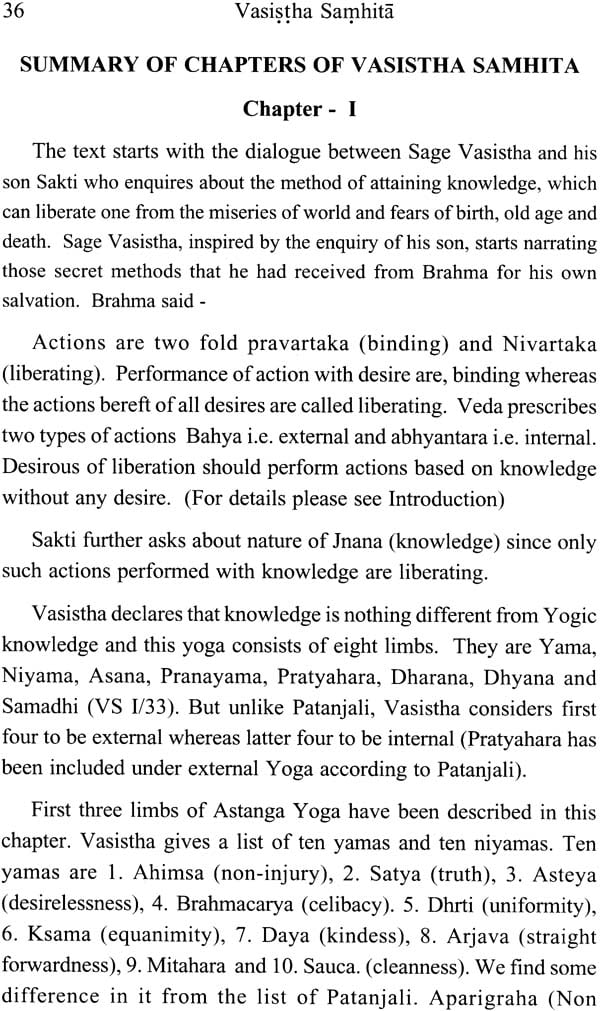
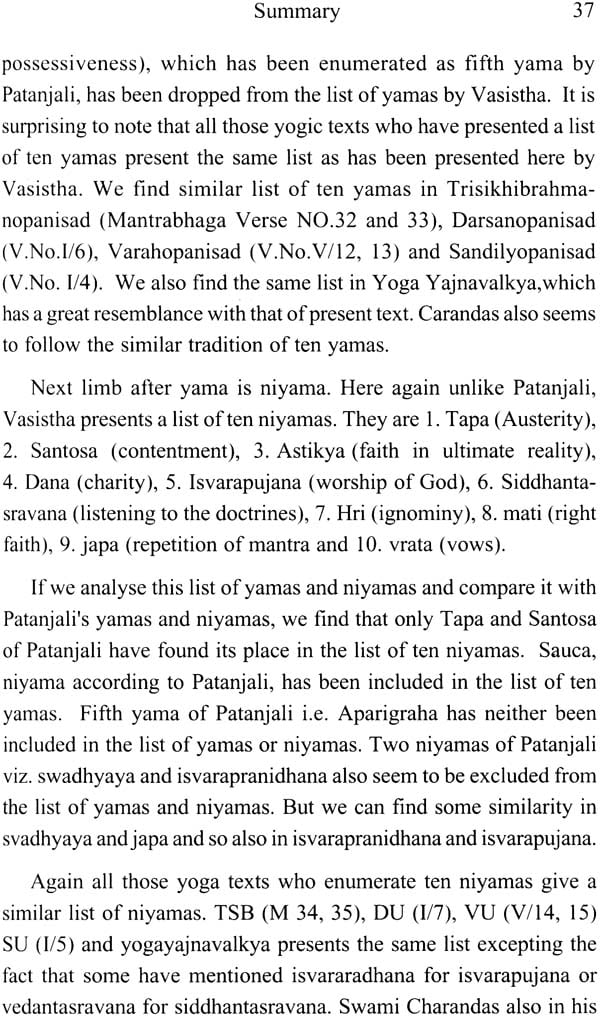
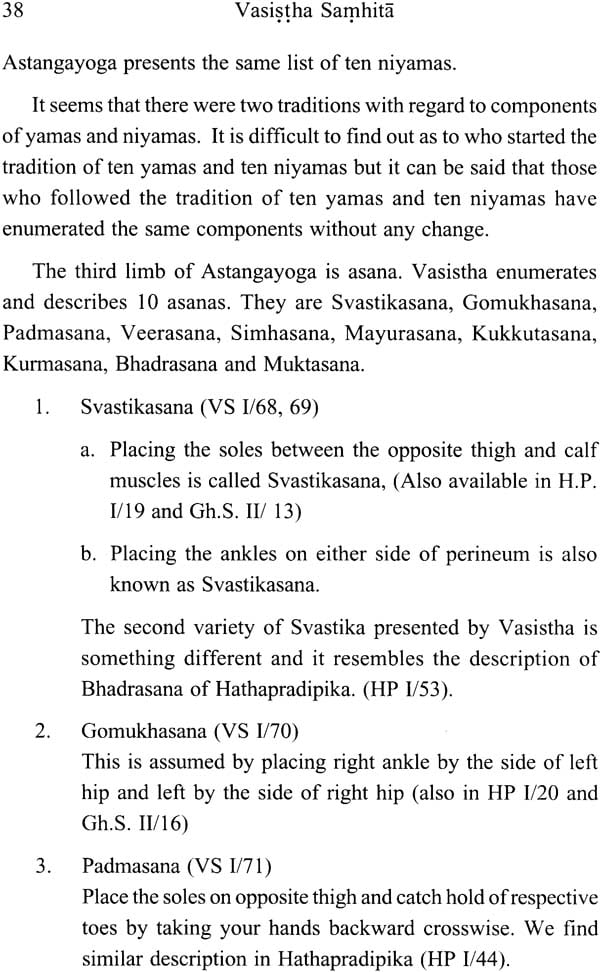
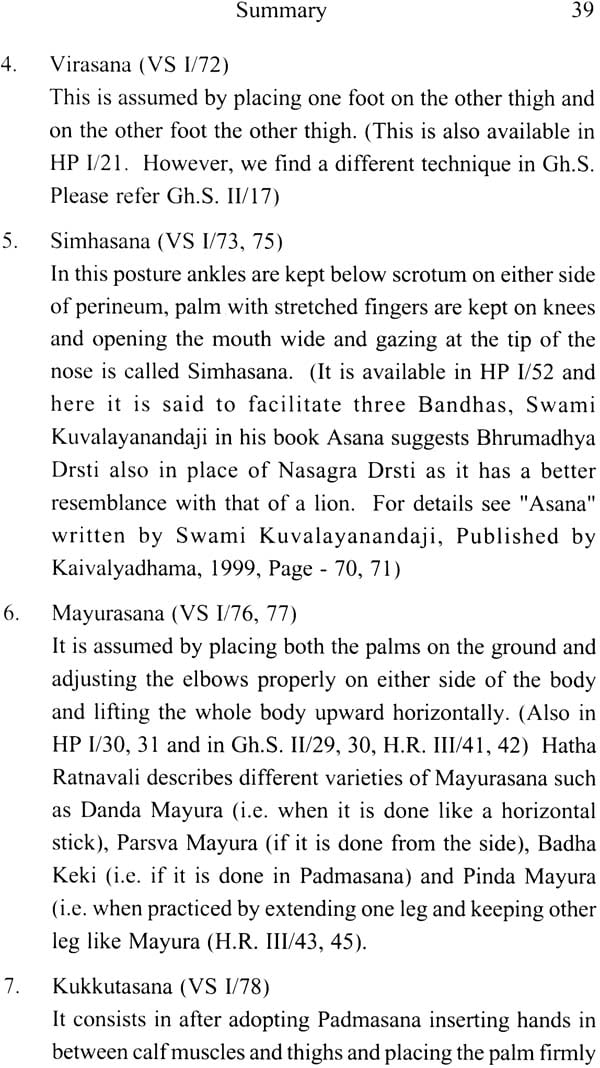
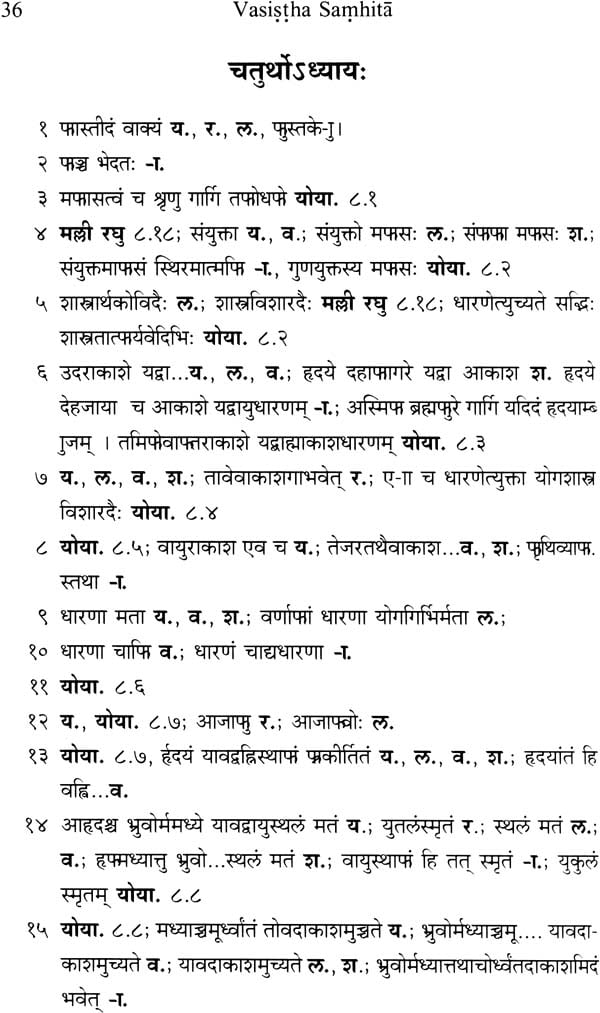


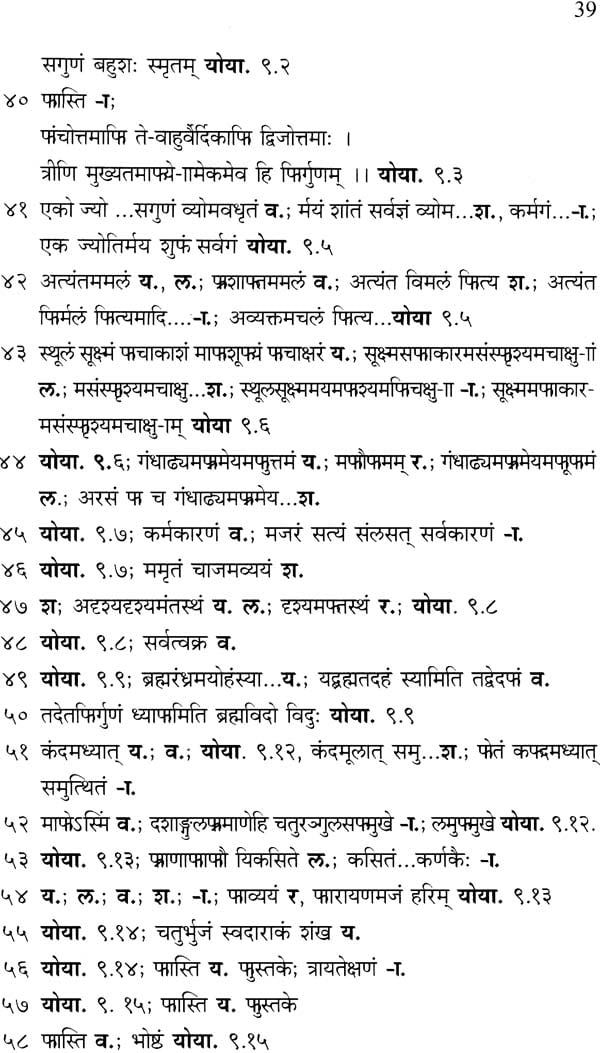
Click Here for More Books Published By Kaivalyadhama, Lonavala





